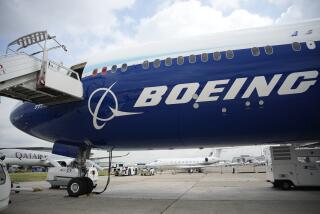Airbus Sinks Further Into Disarray
- Share via
Airbus’ top executive abruptly resigned Monday, just three months after taking the helm in a previous management shake-up and less than a week after rolling out a controversial plan to restructure the troubled aircraft maker.
Airbus parent European Aeronautic Defense & Space Co. said it had accepted the resignation of Christian Streiff, the first outsider to hold the top post at the world’s largest manufacturer of commercial jetliners. EADS said Streiff would be replaced by Louis Gallois, its co-chief executive.
Streiff’s departure, which came after he ran afoul of politicians in four countries, raised more questions about Airbus’ future and whether it could regain its competitive edge against archrival Boeing Co. With Airbus distracted by production woes, Boeing has been able to significantly outpace Airbus in aircraft orders this year.
Streiff’s resignation could scuttle his proposal to dismantle a convoluted production system that some aerospace analysts blame for the delays in Airbus’ much-touted new aircraft, the double-decked A380. Problems with wiring installation are expected to delay by two years delivery of what would be the world’s largest passenger plane. The delay is expected to cost Airbus more than $6 billion over the next four years.
“Streiff’s resignation is a significant signal that Airbus is not going to change even though they are in a desperate situation,” said Hans Weber, president of aerospace and technology consulting firm Tecop International. “He knew exactly what was wrong, and he knew Airbus needed a dramatic change. Now, that is likely dead.”
The resignation came less than a week after Streiff announced the A380 delays and proposed a major restructuring, including slashing costs by 30%, cutting an unspecific number of jobs and shuttering plants.
But the proposed reorganization quickly created a political firestorm in Europe, where Airbus is a major employer in several countries and has been seen as a model of European cooperation. Airbus, headquartered in Toulouse, France, has 16 large production facilities in England, France, Germany and Spain. Major assembly work is carried out in Toulouse and Hamburg, Germany.
The A380’s large fuselage sections are assembled in Hamburg, then shipped to Toulouse, where they are mated with the wings. The fully assembled aircraft is flown back to Hamburg, where it is painted and equipped with seats. The completed plane is flown back to Toulouse for delivery to the customer. Streiff was considering having the A380 assembled entirely in Toulouse.
A spokesman for EADS denied speculation that Streiff, 52, was forced out because of his plans to restructure the company but acknowledged that last week’s announcement created political discord.
“If you have to do tough restructuring in Europe, it is important that you have people who have diplomatic and political sensibility,” EADS spokesman Michael Hauger said. “This is an area that Streiff hasn’t been that strong.”
Streiff, a newcomer to the aerospace industry, was hired to turn around Airbus after EADS ousted its co-executive Noel Forgeard and Airbus head Gustav Humbert in July after a second production delay for the A380. Streiff had been credited with revamping a unit of French conglomerate Saint-Gobain Group, the world’s largest supplier of building materials.
“He wanted Airbus to be an independent company,” Hauger said in a telephone interview from EADS’ headquarters in Munich, Germany. It also has headquarters in Paris, reflecting the Franco-German alliance that helped create the consortium.
Hauger said the consortium’s board had planned to “more fully integrate Airbus into EADS” and was surprised that Streiff “didn’t want to go along with it.”
A consortium of aerospace companies -- many of them owned by European governments -- created Airbus in 1971 as a way to compete with Boeing, the Chicago-based aircraft maker which at the time was the largest maker of passenger jets.
Airbus eventually became a unit of EADS, and in the last decade the European governments had been shrinking their stakes in EADS with the goal of eventually turning Airbus into a private entity similar to Boeing. In recent months, however, some state-owned banks have expressed interest in acquiring large stakes in EADS.
Analysts said Monday that Streiff’s resignation could push the European governments to “re-nationalize” the aircraft maker, a move that could hurt Airbus chances to win a multibillion-dollar competition to make aerial refueling tankers for the U.S. Air Force.
Airbus is teaming with Century City-based Northrop Grumman Corp. to build the tankers by altering the design of the Airbus A330 passenger plane. It would compete with Boeing’s proposal of a modified 767 jetliner. The contract potentially could be worth more than $25 billion.
The Air Force has said European government involvement in the program and the effect it would have on a trade dispute under review by the World Trade Organization could be a factor in the competition.
“As government increases influence, the opportunity for selling tankers goes away,” said Weber of Tecop International.
Under the new management system, EADS’ other co-chief executive, Tom Enders, will be in charge of defense and space businesses.
Gallois, 62, ran France’s state-owned aerospace company Aerospatiale and headed the French rail system for a decade before taking the top post at EADS three months ago.
Airbus also said it would decide within a few weeks whether to begin development of the A350 XWB, a mid-size jet that would compete with Boeing’s 787, a fuel-efficient 250-passenger aircraft that is expected to enter service with airlines in mid-2008.
More to Read
Inside the business of entertainment
The Wide Shot brings you news, analysis and insights on everything from streaming wars to production — and what it all means for the future.
You may occasionally receive promotional content from the Los Angeles Times.










